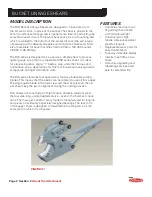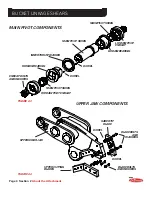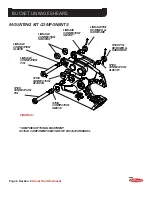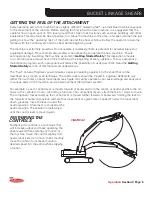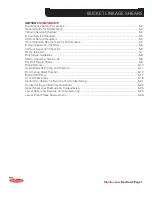
BUCKET LINKAGE SHEARS
Page 2 Section 4
Operation
BEFORE YOU START
KNOW YOUR SAFETY PROGRAM
1.
Read and understand the safety section of this
manual and the base machine manual.
2.
Know the employer’s safety rules for your job.
Consult your foreman for specifi c instructions and
safety equipment required.
3.
Learn the traffi c rules at the work site.
4.
Know the hand signals used on the job and who
is responsible for signaling. Take signals from only
ONE person.
KNOW YOUR EQUIPMENT
•
Learn the location and function of all controls.
Test all controls to ensure proper operation. If
any malfunctions are found, shut the machine
down and report the malfunction for repair.
•
Be familiar with the safety devices on the
machine, indicators, warning devices and
caution instructions. They will alert you to
conditions that may make it hazardous to
continue operating.
•
Wear proper protective clothing including hard
hat, safety shoes, ear protectors, refl ective
clothing, safety goggles and work gloves. Loose
clothing can get caught in machinery and
cause injury. Wrist watches, rings and other
accessories can be dangerous, as well.
•
Know the clearances in the work area. A
little time spent checking side and overhead
clearances, including power lines, can save a lot
of trouble.
FIRST THINGS FIRST
1.
Ensure all safe viewing distance decals are
installed and legible; contact LaBounty for
replacements as required.
2.
Have a DAILY Safety Dialog with all those with
whom you work. Inform them of any out-of-the-
ordinary work that may be planned for the day.
Remind them of the safe working distance.
3.
Clear the area; inspect.
ALWAYS
look out for
others. In any work area, people constitute a
serious safety hazard. Before operating, walk
completely around the machine to be sure there
are no workers next to, under or on it. Warn nearby
workers that you are starting up;
DO NOT
start up
until they are out of danger.
4.
Each day before starting, visually inspect the
machine by walking around it entirely; check the
location of cables, gas lines, and water mains
before any operations. Make sure work site
footing has suffi cient strength to fi rmly support
the machine. When working close to an excavation,
position machine with the propel motors at the rear.
5.
Once started, keep bystanders clear, especially
before moving the boom, swinging the upper
structure, or traveling.
ALWAYS
be alert for
bystanders in or near the operating area.
SAFETY DEVICES YOU’LL NEED
SAFETY DEVICES
Seat belts
Canopies
Falling Objects Protective Structures (FOPS)
Shields and guards
Safety decals
Visual or audible warning devices
Flags and fl ares
Barricades
Signs and other markings
Warning lights

